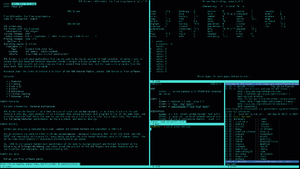GNU Screen

GNU Screen with split-screen
|
|
| Developer(s) | Amadeusz Sławiński, Alexander Naumov and the GNU Project |
|---|---|
| Initial release | 1987 |
| Stable release | 4.4.0 (June 19, 2016) |
| Preview release | None |
| Repository | git |
| Development status | Active |
| Written in | C |
| Operating system | Unix-like |
| Type | Terminal multiplexer |
| License | GNU GPL v3 |
| Website | www |
GNU Screen is a terminal multiplexer, a software application that can be used to multiplex several virtual consoles, allowing a user to access multiple separate login sessions inside a single terminal window, or detach and reattach sessions from a terminal. It is useful for dealing with multiple programs from a command line interface, and for separating programs from the session of the Unix shell that started the program, particularly so a remote process continues running even when the user is disconnected.
Released under the terms of version 3 or later of the GNU General Public License, GNU Screen is free software.
GNU Screen can be thought of as a text version of graphical window managers, or as a way of putting virtual terminals into any login session. It is a wrapper that allows multiple text programs to run at the same time, and provides features that allow the user to use the programs within a single interface productively. This enables the following features: persistence, multiple windows, and session sharing.
Screen is often used when a network connection to the terminal is unreliable, as a dropped network connection typically terminates all programs the user was running (child processes of the login session), due to the session ending and sending a "hangup" signal (SIGHUP) to all the child processes. Running the applications under screen means that the session does not terminate – only the now-defunct terminal gets detached – so applications don't even know the terminal has detached, and allows the user to reattach the session later and continue working from where they left off.
Screen was originally designed by Oliver Laumann and Carsten Bormann and published in 1987.
...
Wikipedia
